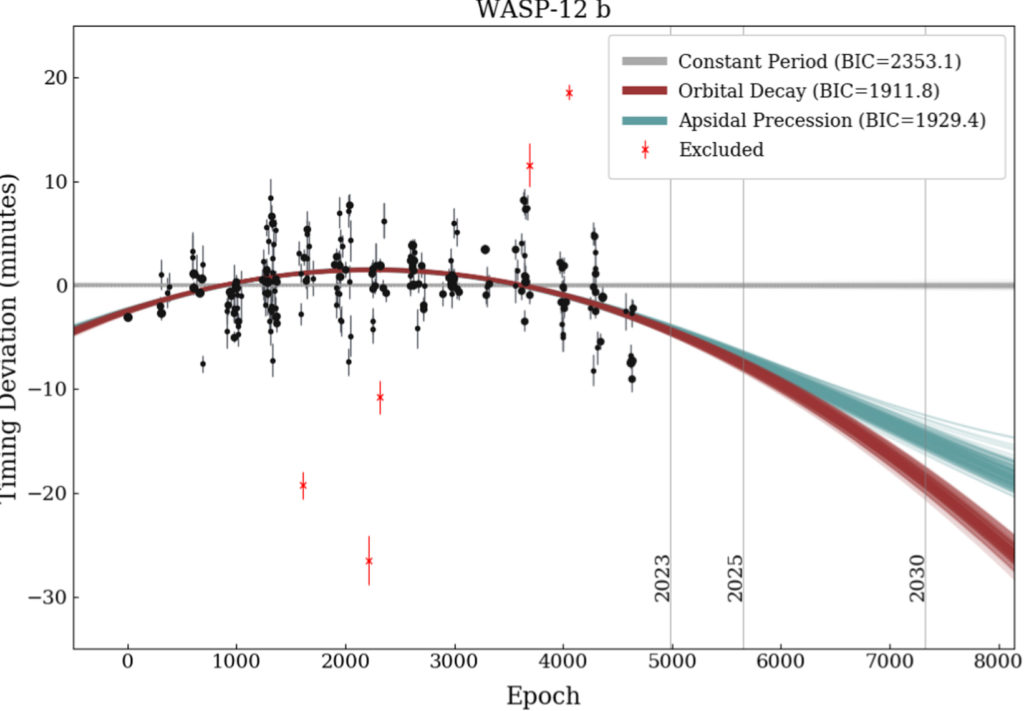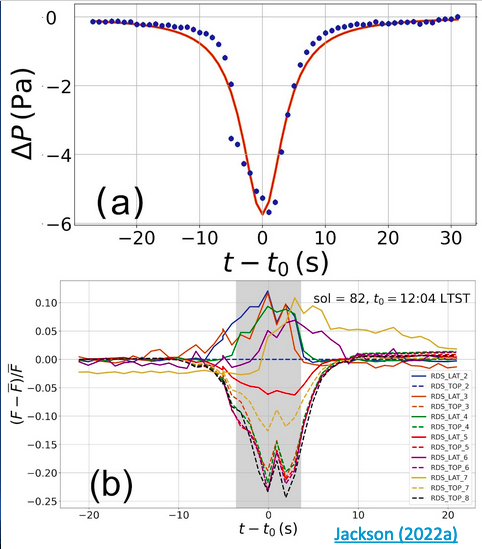Estimating Aerodynamic Properties of Planetary Surfaces Using Drone Attitude
This presentation is based on a paper published here – Jackson, B. (2022) RNAAS.
Estimating Aerodynamic Properties of Planetary Surfaces Using Drone Attitude
This presentation is based on a paper published here – Jackson, B. (2022) RNAAS.
Evidence of Long-term Period Variations in the Exoplanet Transit Database (ETD)
https://iopscience.iop.org/article/10.3847/1538-3881/ac959a


able 4. Model Comparison for Secondary Analysis—Data Variance for ETD Transit Times
| Target | Decay Rate | 1σ Unc. | BIClinear | BICdecay | ΔBIC |
|---|---|---|---|---|---|
| (ms yr−1) | (ms yr−1) | ||||
| WASP-12 b | −34.8 | 4.9 | 223.7 | 202.7 | −21.0 |
| HAT-P-19 b | −64 | 17 | 80.6 | 78.2 | −2.4 |
| TrES-1 b | −16.0 | 3.7 | 73.3 | 68.3 | −5.0 |
| WASP-4 b | −6.7 | 2.4 | 62.6 | 62.7 | 0.1 |
| TrES-2 b | −22.0 | 8.0 | 159.0 | 160.3 | 1.3 |
| TrES-5 b | −25 | 11 | 118.3 | 120.5 | 2.2 |
| HAT-P-32 b | −32 | 12 | 95.5 | 96.7 | 1.2 |
| WASP-10 b | −10.1 | 7.6 | 131.6 | 135.5 | 3.9 |
| WASP-43 b | 3.5 | 4.0 | 126.5 | 130.9 | 4.4 |
| TrES-3 b | 0.01 | 1.9 | 227.8 | 233.1 | 5.3 |
An key source of dust, dust devils help drive weather and climate on Mars. With a sophisticated suite of meteorological instruments, the Mars 2020 Perseverance rover can detect when a dust devil passes nearby — the instruments can see the pressure and dust perturbations from the dust devils. (Wind data were not available by the time of our work, so we didn’t include any — oh, well, next time.)

In a two new studies, my research group used data from Mars 2020 to look for passing dust devils and spotted almost 1000 encounters over the missions first 178 days. We confirmed previous weather predictions that Mars 2020 would see more than other recent missions, including InSight and Curiosity. We also found out that there were lots of whirlwinds that passed by Mars 2020 that actually didn’t raise any dust — only about a quarter of whirlwinds showed any signs of dust-lifting.
These kinds of studies are important for understanding the martian dust cycle and the contribution from dust devils. Scientists know Mars’ dust cycle strongly affects climate, and increases in atmospheric dust increase the rate of water loss into space. Martian dust may even be toxic, so dust devils could pose a big hazard for humans on Mars.

WASP-12 b is in trouble. A giant ball of mostly hydrogen, the planet circles its star once every 25 hours. The resulting intense stellar irradiation drives super-sonic storms of plasma around the world, and the atmosphere has so much thermal energy, in fact, that some of it is escaping into space. But it gets worse. WASP-12 b is steadily tumbling toward its host star, and astronomers expect that, within a few million years, the star will eat the planet.
WASP-12 b is one of a few hundred hot Jupiters, gas giants very close to their stars, and so far, it’s the only one we have confirmed in a death spiral. Many other hot Jupiters probably are probably also condemned, but how many more can we find perched on the edge of destruction? And, come to think of it, how did the planets find themselves in such precarious positions in the first place? To answer these questions, astronomers need to understand how many hot Jupiters there are out there and how many more are left to be found.
Continue Reading